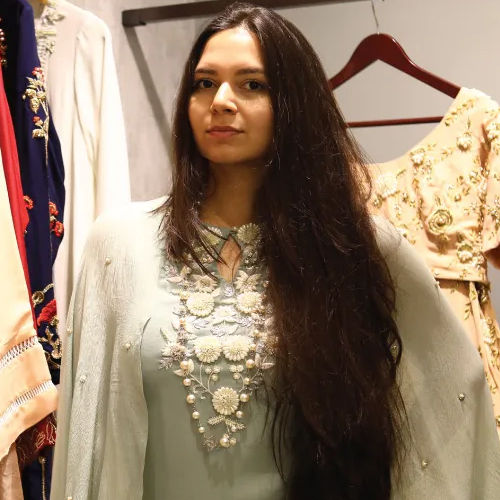
Varsha Wadhwa
Founder
VW
We will launch our website soon
Coming from a family that ran a business of jute and linen mills since 1873, Varsha Wadhwa's dream was to follow her passions and create something of her own some day. Armed with a foundation in art and design from London College of Fashion and fashion design from Istituto Marangoni, Milan, she came back to India to launch her own luxury brand VW. Her demi-couture womenswear line exudes her personality and love for all things vintage and timeless. Wadhwa gets chatty about her sustainable prêt-line and shares future plans for her label in an interview with Fibre2Fashion.
Fibre2Fashion: Tell us about your early years in the fashion industry. How has your label evolved since the set up in 2016?
Varsha Wadhwa:
I launched my label Varsha Wadhwa in June 2016, and what an exciting journey it has been in the last two years! Anyone I meet says he feel like I have been around longer than that, and honestly it has been constant learning since the minute go. We are finding our own voice creatively and exploring what works in terms of our clientele and I see a dramatic shift in that where we have different cities and stores catering to different ages. The whole experience has been one filled with learning, hard work, perseverance and so much fun!
F2F: What is your inspiration for creating clothes?
VW:
F2F: What does sustainability mean to you? How successful have you been in incorporating sustainability into fashion?
VW:
Sustainability in fashion, with this ever-changing global economy and environment, would mean to create clothing which is not harmful to the environment in terms of choice of raw materials and fabrics. For example, we use organic bamboo and soyabean for our prét line that is made using lesser water and lower wastage. In London this summer, I visited an exhibition at the Victoria and Albert Museum called 'Fashioned from Nature', which presented fashionable dresses alongside natural history specimens, innovative new fabrics and dyeing processes, inviting visitors to think about the materials of fashion and the sources of their clothes. It gave me further ideas on what more can be done to preserve the future in fashion.
F2F: How is Indian fashion perceived at the international level?
VW:
Reinventing traditional embroidery and appliqué skills in garments free from Bollywood bling, yet retaining the quintessentially Indian high embellishment aesthetic, using traditional craft skills, the Indian fashion industry is slowly but surely paving its way to get noticed internationally. With Prime Minister Narendra Modi inaugurating the 'Make in India' week, a gargantuan event in which the government estimated participation of over 1,000 companies and delegates from over 60 countries, India has become a reckonable powerhouse considering it is the second largest textile manufacturer in the world.
F2F: If given an opportunity, which international designer would you like to collaborate with and why?
VW:
At this point, honestly I can't think of anyone. There are some amazing designers in India and abroad, but I feel there is so much more to explore and do before collaborating as the label is too young.
F2F: What is the next big thing in your list?
VW:
To have my label showcased in a few select top stores all over the world and possibly present at a fashion week in India with a flagship store in works.
F2F: What is the projected turnover by 2020?
VW:
With a growth rate of 400 per cent since inception, we hope to grow in perpetuity.
F2F: Where do you source raw materials from?
VW:
I source my raw materials from Kolkata, Bihar, New Delhi, Mumbai and Hong Kong.
F2F: What is the staff strength at your workshop?
VW:
We have a small team of around 30 people, who are like family, as we don't have a typical stressed situation, I truly believe in having a happy work environment as we spend the majority of our day at work.
F2F: What is the average time taken to make a garment?
VW:
Depending on the style and the collection, prét or demi-couture, the average time could range anything from three days for a sleek dress to three weeks for a heavily hand-embroidered ensemble.
F2F: What will be the latest trends for the festive/wedding season 2018?
VW:
Wide leg bottoms - shararas and pallazos, wrap arounds - angrakhas, lots of blingy silver and metal accents, and pre-draped fuss-free sarees. More fun, feminine and easy going.
F2F: What is the design strategy? What is the strength of your designing team?
VW:
The design strategy as such is not much; I like to focus on things I am inspired by. Every season there is a thought or an idea, which over time just evolves into the theme of the collection. I do follow some of the trends but stick to the aesthetics of the label to maintain consistency. The design team for now is basically me and my assistant designer. I like to create myself as I see myself more as an artist than a businesswoman.
F2F: How many collections do you come up with in a year? How many styles in each collection?
VW:
We come up with three to four collections in a year with 20-25 styles in each.
F2F: What about your retail presence?
VW:
We're currently located in various multi-brand stores, such as Aza and Fuel in Mumbai; 85 Lansdowne in Kolkata; Vesimi in Dubai; Raya in Chandigarh; Panache in Ahmedabad; and Pernia's Pop Up Shop, Aza, and Rock n Shop online. And we have done custom collections for Kitsch in New Delhi and Amethyst in Chennai. We are due to launch our own website next month.
F2F: What steps can be taken to promote young designers at the retail level?
VW:
Anurag Batra
Rahul Mehta
Pradip Mehta
Aseem Prakash
Bill D’Arienzo
Gabi Seligsohn
Abhay Gupta
Rahul Mehta
Fanny Vermandel
Arun Sirdeshmukh












_8.JPG)


